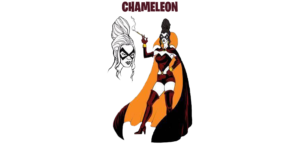Resist the Destructive Force of Status-Quo Thinking and Defeat Chameleon

…is true to her name and makes certain she fits in, conforms to the status-quo, keeps her head low, follows the rules (loves checklists) and stays in her prescribed lane. She does not challenge assumptions or ask why we do things the way we do. She is very boring…quite stifling in fact, and as a result perpetuates more-of-the-same thinking and generates nothing unique.
Her Resistive Powers are:
- Overemphasize the Status-Quo
- Conform to the Pressure of Rules, Traditions, Culture and Social Influences
Take these actions this week to strengthen your creative thinking muscle, anchor the creative habit to be repeatable…and conquer the Resistive Powers of Chameleon!
- Challenge Underlying Assumptions: Underlying assumptions are just that – underlying and hidden. Often, we do not take the time to surface them, let alone challenge them. Assumptions are firmly imbedded in our thinking and perceiving – yet often are hidden. Habits form around these hidden assumptions; routines get established and eventually no one wants to break out of their comfort zone – even if that is causing us to perform at a less than optimal level. We ‘go along to get along’ instead of challenging ourselves or each other to prosper. So, shake it up and start challenging assumptions. First, surface them by asking: ‘What assumptions am I/we making about this issue/problem/situation? Second, take each of the assumptions and distort it by asking: ‘What would happen if I/we reversed this assumption?’ Third, with each reversed assumption ask: ‘How can I/we use this reversed assumption?’ What ideas does it spark? At a minimum you will break your fixed thinking and perceiving patterns. Better yet you will generate increased levels of novel thinking!
- Be Independent in Thought and Resist Conformity: Resist conformity you exhort! Easy to say – tougher to do. Just suppose we live in a corporate culture where the dominant color is green. We do things the green way, we like green ideas/concepts/solutions, and we are looking for greener thank you! Just suppose you have a violet idea – in fact, your way of thinking and perceiving produces many more violet ideas than green. The leaders proclaim they want diversity in thinking, want people to take risk and fail fast. Yes possibly, however violet is not green, and the two colors may not mesh well…or can they? What is a creative thinker to do? You only get one chance to make a favorable first impression so take the following steps to improve your odds. (1) Synthesize your idea(s) into an organized, straightforward back of the envelope concept/solution by giving it a name and describing it in two – three sentences. (2) Explain how it works; the problem it solves for the customer and your organization; what is unique about it; and the economic value it will generate even if it is difficult to do so. (3) Outline where the concept/solution could potentially get stuck in quicksand and the preventative ways you’ve identified to avoid the quicksand. (4) When you present the concept/solution, communicate the essence of it by showing its relationship to something that is known, understood and valued by your audience. With this approach you will demonstrate that the concept/solution you developed nicely integrated violet with green…and better yet…produced a beautiful blue.
- Re-Spark your Natural Curiosity: To quote the brilliant and acclaimed physicist Albert Einstein: ‘The important thing is not to stop questioning. Curiosity has its own reason for existing. One cannot help be in awe when he/she contemplates the mysteries of eternity, of life, of the marvelous structures of reality. It is enough if one tries merely to comprehend a little of this mystery every day. Never lose your curiosity.’ This underscores the vital importance of the front-end of creative-problem-solving, namely identifying and defining the best challenge, problem, opportunity to go after, to solve. A very big part of the equation are the questions. Take action and develop your go to set of questions and statement starters to use in your creative-problem-solving efforts. The power with this is it will continually spark your curiosity, and you can repurpose this list of questions/statement starters to a host of different challenges, situations, issues, problems and/or opportunities. To borrow from Mary Poppins, these are a few of my favorites things/questions/statement starters: ‘Why…?’ ‘Why not…?’ ‘Just Suppose…’ ‘What if…?’ ‘If only…’ ‘I Wish…’ ‘Wouldn’t it be great it if…?’ ‘What I really like about that is…’ ‘The potential I see with that is…’ ‘What if we reversed it and did the opposite?’ ‘In a world where that is real, the power I see is…’